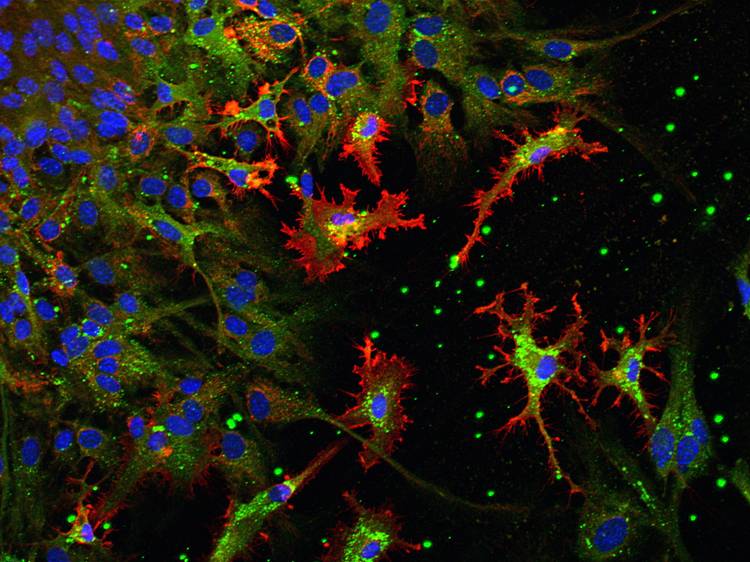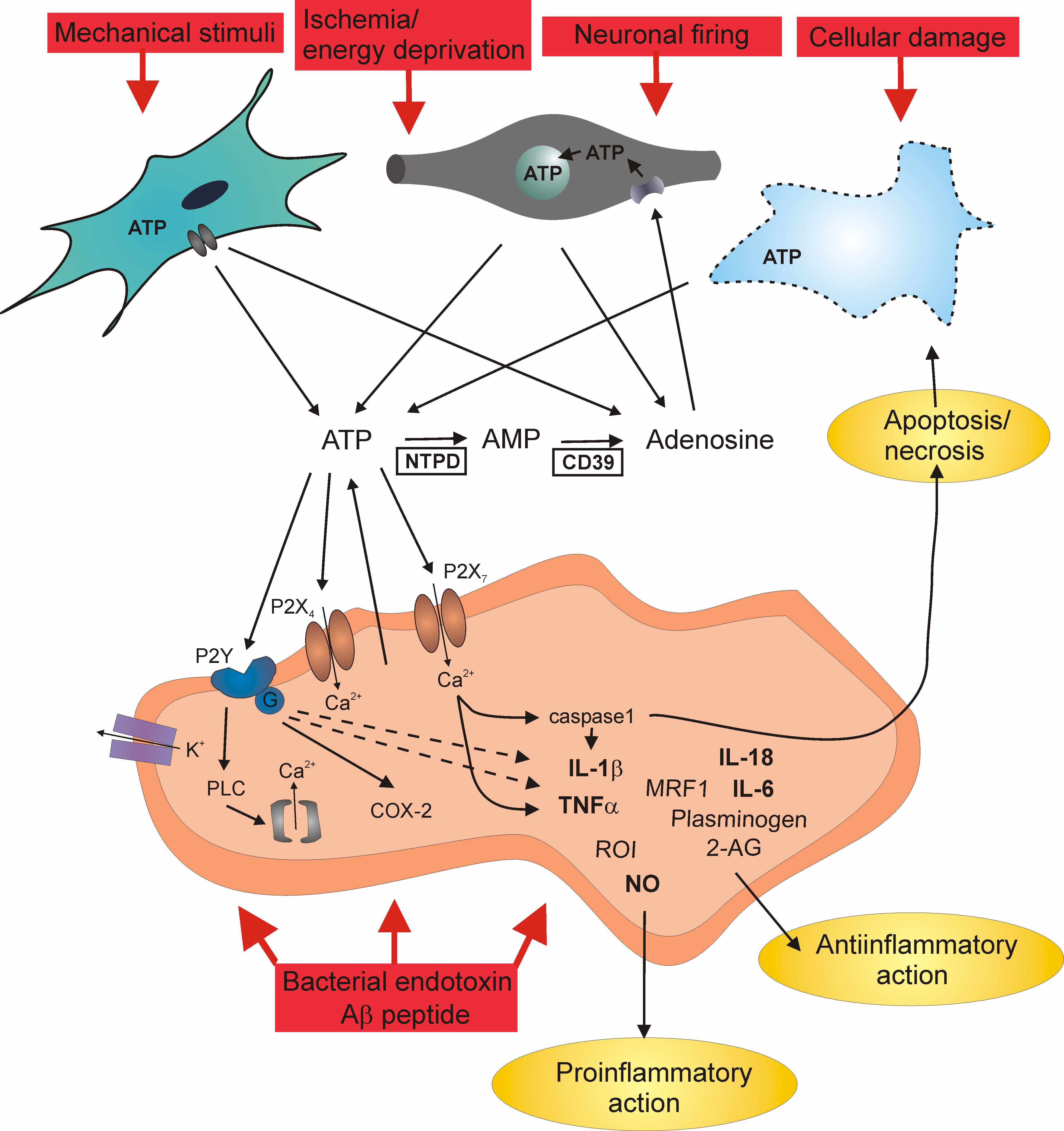Ongoing research projects:



1. Purinergic signalling in the nervous system
The purine nucleotide ATP is an important neurotransmitter, neuromodulator and gliotransmitter in the nervous system. ATP and its extracellular breakdown product adenosine are released from neurons and glial cells upon neuronal activity and pathological signals and act on ionotropic P2X (P2X1-7), metabotropic P2Y (P2Y1,2,4,6,11,12,13,14) and adenosine (A1, A2A, A2B, A3) receptors. Through these actions purines participate not only in physiological information processing but also in the pathogenesis of neuro-psychiatric disorders and pain. The Sperlágh lab provided a major contribution to the knowledge on purinergic signalling, publishing more than 50 original papers in the past two decades in this field. Their achievements include the first demonstration of the presynaptic facilitation by P2 receptor activation, elucidation of the source and mechanisms of ATP release, identification, mapping and characterization of P2X and P2Y receptors involved in the regulation of transmitter release and nucleotide catabolizing ectoenzymes (ectoATPase, adenylate kinase). In addition to traditional methods, their technical repertoire includes high resolution purine detection methods, e.g. the recently introduced microelectrode biosensor technique and system based approaches, such as microarray experiments.
A particular focus of their current interest is the ionotropic P2X7 receptor, which is a unique subtype of the P2X receptors expressed on nerve terminals, glia and hematopoietic cells. The group of Dr. Sperlágh discovered that the activation of this receptor leads to increased glutamate and GABA release in the brain. Moreover, they showed that both the expression and functional responsiveness of P2X7 receptors in the brain are increased upon pathological stimuli, such as in vitro ischemic-like conditions. Based on these results they proposed P2X7 receptor as a new target in various CNS diseases such as neuropathic pain, depression and schizophrenia. The group works on the validation of this hypothesis, and on the identification of the mechanism of action of P2X7 receptor antagonists using various in vivo animal models and in vitro studies. Their ongoing studies suggests that genetic deletion and pharmacological blockade of P2X7 receptors leads to antidepressant and mood stabilizing phenotype, reproducing neurochemical and behavioral hallmarks of antidepressants.
Another focus of the research is the metabotropic P2y12 receptor. Uniquely from P2X and P2Y receptor families, the P2Y12 receptor is the molecular target of clinically utilised drugs, i.e. it is targeted by widely used blockbuster antithrombotic drugs, such as clopidogrel. Accordingly, P2Y12 receptors are highly expressed on platelets and their activation by ADP results in rapid thrombocyte aggregation. However, P2Y12 receptors are also expressed in the central nervous system, i.e. on microglia which raise the possibility their utilization as a potential target in different pain modalities and neuroinflammatory diseases. The current results of the group indicate that P2Y12 receptor antagonism leads to analgesic effect in inflammatory and neuropathic pain.


2. Receptor mediated modulation of neurotransmitter release
Although chemical signaling has a key role in all neural functions, measurements of transmitter concentrations and modulators directly in the extracellular space are rather rare. The main reason for this is that in case of the traditional paradigm of synaptic transmission, transmitter release is proportional to the postsynaptic events and therefore could be efficiently monitored by electrophysiological recordings of postsynaptic events. However, several lines of recent evidence indicates that classical concepts of chemical neurotransmission represent oversimplified views. Even the fast-acting transmitters can act in a non-classical fashion, such as glutamate and GABA, which can “spill over” from synapses, or have quasi-paracrine actions maintaining tonic levels, or activating receptors by diffusion over large areas leading to important functional consequences. These observations are even more valid for slow transmitters and non-conventional mediators, such as 5-HT and peptides. More than ever before, there is a need to perform direct measurements to answer important questions on the timing, dynamics, quantity and spatial localization of the release of different transmitters. The overall aim of our current studies is to understand how the different (i.e. fast and slow) activity patterns of median raphe (MR) neurons are translated to different patterns of neurotransmitter release in one of its target areas, the hippocampus. Using the optogenetic technique, we examine how photostimulation affects glutamate and 5-HT release from the terminals of ChR2/eGFP /virus-labelled MR neurons in acute hippocampal slices. We assume that selective stimulation of ChR2-containing raphe-hippocampal fibres with different paradigms will result in qualitative and quantitative changes in the efflux of transmitters. Identifying the principles of these changes will help to understand the role of different transmitters, in particular glutamate and 5-HT, in subcortical modulation of network activity and behaviour in collaboration with our intramural partners. In addition we plan to explore modulatory mechanisms by M1, a2, NMDA, AMPA GABAA, GABAB and P2 receptors converging on the terminals of ChR2/eGFP /virus-labelled median raphe neurons.
3. Neurochemical basis of neurodegenerative diseases
Neurodegenerative diseases (Parkinson disease, Alzheimer’s disease, stroke, etc.) are characterized by the progressing loss of neurons and typically occur in the elderly population, therefore they represent considerable economic and social burden and their incidence is continuously rising. Nevertheless, the treatment of neurodegenerative diseases is not resolved yet despite the extensive efforts to understand the biological basis of neuronal death and survival. The most likely reason for the failure is that the process leading to neurodegeneration is remarkably complex and involves numerous self-amplifying and complementary mechanisms on subcellular, cellular and system levels. Therefore, compounds acting at single targets are unlikely to result in clinically beneficial action. Recently, a new concept of drug development has been elaborated in the lab, utilizing drugs with multiple mode of action. The pathological interaction of mitochondrial dysfunction and oxidative stress is well known to play a determinant role in the development of the neurodegeneration. Dr Sperlágh’s group revealed that mitochondrial dysfunction and oxidative stress have supraadditive impact on pathological, cytoplasmic accumulation of monoamines and their subsequent release in animal models of ischemia and Parkinson’s disease. Moreover, they showed that this oxidative stress induced, pathological monoamine release provides an additional source of highly reactive free radicals during their breakdown, but only if there is a preceding mitochondrial dysfunction. Therefore, those drugs, which simultaneously target mitochondrial dysfunction, oxidative stress and pathological dopamine release may have disease-modifying potential in addition to symptomatic improvement. Utilizing national (Department of Medicinal Chemistry, Semmelweis University, Budapest) and international (ICES, A*STAR, Singapore) collaboration with medicinal chemists, the lab works on the translation of this concept to antiparkinsonian drug design.

